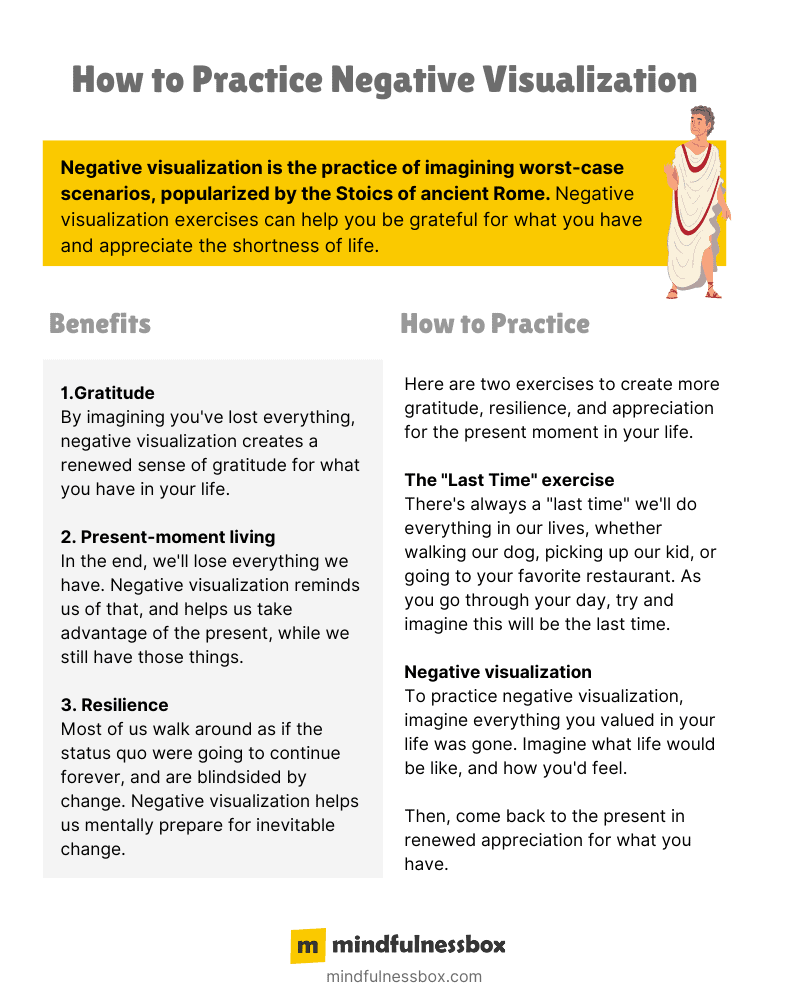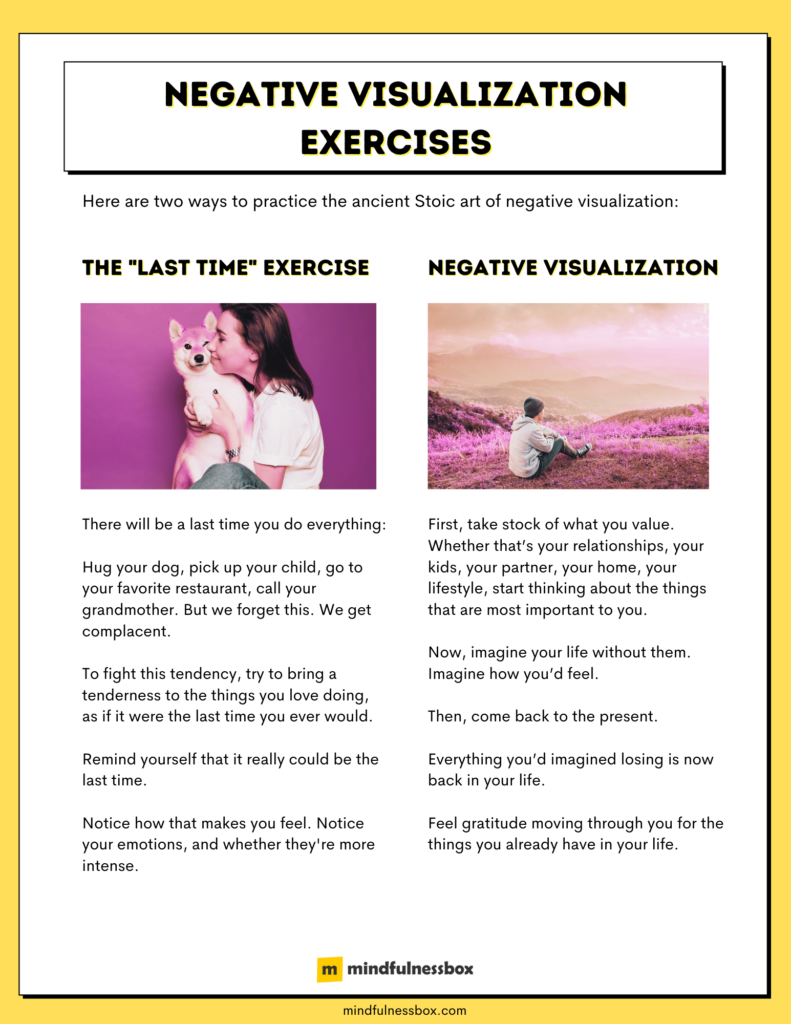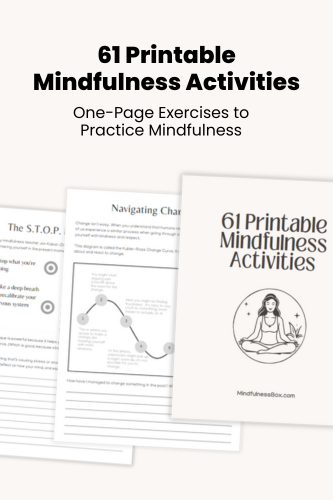Negative visualization is the practice of imagining worst-case scenarios, popularized by the Stoics of ancient Rome. Negative visualization exercises can help you be grateful for what you have and appreciate the shortness of life.
The Stoics of ancient Rome walked around imagining all manner of illnesses, deaths, and worst-case scenarios that could happen to them and their loved ones.
It’s called negative visualization—and counterintuitively, all that negative thinking might help you live a better life.
Get dozens of one-page exercises to help practice mindfulness, meditation, gratitude, and self love. Perfect for printable handouts when teaching mindfulness to groups, students, or in the workplace.
To see examples, plus a full list of the 61 exercises included, click below.
I was first introduced to the idea of negative visualization by the book A Guide to the Good Life by William Irvine. Negative visualization is the term Irvine uses for this intellectual exercise common to the Stoics of ancient Rome.
The Romans called it premeditatio malorum, or “the pre-studying of troubles.”
They made it a practice to imagine all the problems that might befall them in the future, and reflect on them.
By imagining these troubles, they found themselves not only better prepared for those scenarios if and when they did arrive, but more grateful for what they had after exiting the negative visualization.
How to Practice Negative Visualization
Let’s address the name. “Negative visualization” is terrible branding. It makes the whole exercise sound pessimistic and self-indulgent.
I don’t have the power to rebrand it with a single article, but let’s reframe it, at least:
Negative visualization isn’t pessimistic. It’s a way to avoid taking life for granted. It’s another path to gratitude.
By imagining losing everything, you’re preparing yourself to come back to the state of having everything with a new mindset of gratitude.
The Romans had another phrase that goes hand-in-hand with negative visualization:
Memento mori.
It means to remember that you are mortal.
The point of negative visualization is to remember to be grateful for each moment, because everything you have is temporary, including your own life.

Negative visualization examples
Here’s how negative visualization works:
First, take stock of what you value. Whether that’s your relationships, your kids, your partner, your home, your lifestyle, start thinking about the things that are most important to you.
Now, imagine you no longer have them in your life.
Obviously, this can get heavy.
You don’t need to get into the details of how or why you no longer have these things you value, but picture yourself at some indeterminate point in the future without them.
Imagine how you’d feel. Imagine what you’d do to get back to the life you once had. Imagine what you’d trade to simply roll back the clock and go back in time.
Then, come back to the present.
Everything you’d imagined losing is now back in your life.
Practice tapping into new sources of gratitude and joy as you go about your day, appreciating all the things you’re lucky enough to have in your life.
Benefits of negative visualization
It’s so natural to the human condition to start taking what we have for granted. We need every tool possible to combat them, and negative visualization is a powerful way to “reboot” our consciousness. We need frequent reminders that what we love today won’t be around forever.
But negative visualization has another powerful use:
It can make us more resilient.
As Seneca, one of the godfathers of Stoicism, said:
“If an evil has been pondered beforehand, the blow is gentle when it comes… Hence, the wise man accustoms himself to coming trouble, lightening by long reflection the evils which others lighten by long endurance.”
There are a couple points of wisdom that are worth extracting here:
- Hope for the best, prepare for the worst: Anticipating future negative events can lessen the blow if and when they happen. This sounds a little like the common wisdom of “hope for the best, prepare for the worst.”
- Understand risks so you’re not blindsided by reality. Much of our hardships come from adapting to the new reality of a negative event. As Seneca says, we can better endure them once we’ve gotten used to them. This reminds me of the happiness set point—even after difficult life events, we tend to revert to our baseline levels of happiness in a relatively short time. Seneca seems to think we can speed up that process by thinking about those negative possibilities in advance.
There’s always a last time you’ll do something
Here’s another way to apply this lesson, again courtesy of William Irvine, the author of the Stoic manual A Guide to The Good Life.
There’s always a “last time” you’ll do something you love. And sadly, you don’t know when it’ll be.
Whether it’s picking up your kid, going to your favorite beach spot, hugging your mother, going skiing, or playing fetch with your dog, it’s usually impossible to know when your last chance is coming.
Writer David Cain at Raptitude explains this perfectly in his article The Last Time Always Happens Now:
“For ninety-nine percent of these last times, you will have no idea that that’s what it is. It will seem like another of the many middle times, with a lot more to come. If you knew it was the last-ever time you spoke to a certain person or did a certain activity, you’d probably make a point of appreciating it… You wouldn’t spend it thinking about something else, or let minor annoyances spoil it.”
David Cain, Raptitude
The answer, according to Irvine, is to frequently reflect on the fact that all experiences are impermanent, and remind ourselves regularly that each time we do something, it may be the last time.
“By contemplating the impermanence of everything in the world, we are forced to recognize that every time we do something could be the last time we do it, and this recognition can invest the things we do with a significance and intensity that would otherwise be absent.”
William Irvine, A Guide to the Good Life
Applying negative visualization exercises to your life
The easiest way to get started with negative visualization is with the “last time you’ll do something” method.
Next time you hug your child, greet your dog, call a friend, or simply take a walk around the neighborhood, remember that there’s no guarantee you’ll get another chance at it.
Notice your feelings. Are you more present than normal? Is there more intensity to your emotions?
If you want to go deeper, set aside 5-10 minutes to do a negative visualization session.
Imagine yourself at some future point. Everything you value is gone.
Then ease yourself back into reality, ready to approach what you have with a renewed sense of gratitude.


My mindfulness practice kicked off in 2016 with a ten-day silent retreat. Since then, I’ve read dozens of books about mindfulness and completed hundreds of hours of meditation. Thinking about what makes humans happy, calm, and peaceful is endlessly fascinating to me.


